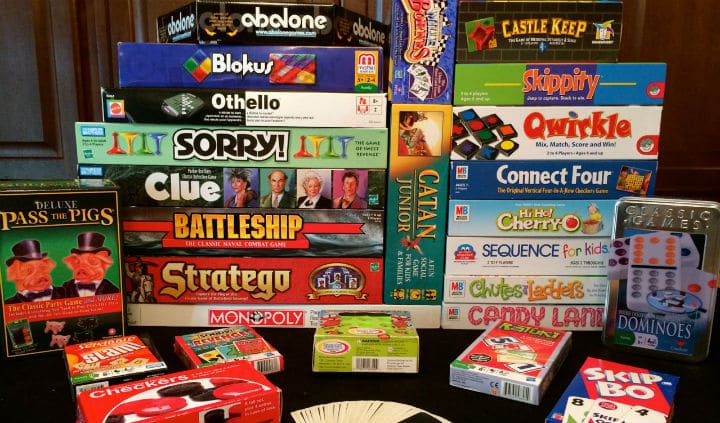Life is crazy. Everyone always seems to have somewhere to go or something to do. Thus, it is a rare and wonderful occasion when you can get together with your friends or your family to play a board game.
Board games started in 5,000 BC with what is now one of the most basic functions of many cherished board games, dice. Two thousand years later, in the courts of the early kings, the board appeared, and a worldwide human pastime was born.
You no longer need to be royal or interested in military strategy to play a board game. Board games are now fun for all the family. Yet that doesn’t mean they have lost their competitive streak.
So, it is in the spirit of competition that we have compiled the 10 Best Cheap Board games for under $20.
Features to Consider in Good Cheap Board Games
All games are constructed with the hope that they will be fun. Some of these games are more ‘classic’ and have stood the test of time. Some are much more suitable for younger or older audiences and some are pick up and play while others take a while to get ready. So, to choose the best board games, these were the features that were examined:
Is It Classic?
The older, popular games are generally revered for the memories that were made while playing them. Some games are fun and timeless simply because they were played while the person was going up. Therefore, a possible drive for buying a game now could be that they find it classic and want to share their experiences with their own children, friends, or possibly relive it with their families. Nostalgia, when it comes to games, especially, is a powerful motivator.
The Age Range?
Board games are usually thought of as a child’s plaything but throughout the past few decades, games have started to return to their roots of entertaining adults. While children still enjoy board games, adults are also getting into the experience, with different games, or with games that can be appropriate for a range of ages. (A game with a wide age range is also a great family game because it can provide a challenge for everyone.)
Ease of Setup?
The ease of setup is important when it comes to board games. No one wants to spend half the time it takes to play the game setting it up. When a group is together and wants to play a game, they want to play it right then and there. So, the ease of setup is essential for focusing in on the best cheap board games for under $20.
These features were decided with the hope of providing potential board game players with the best chance of having a fun and fulfilling experience every time they play the game.
Best Cheap Board Games 2025 (Under $20)
1. Best Overall: Czech Games Codenames
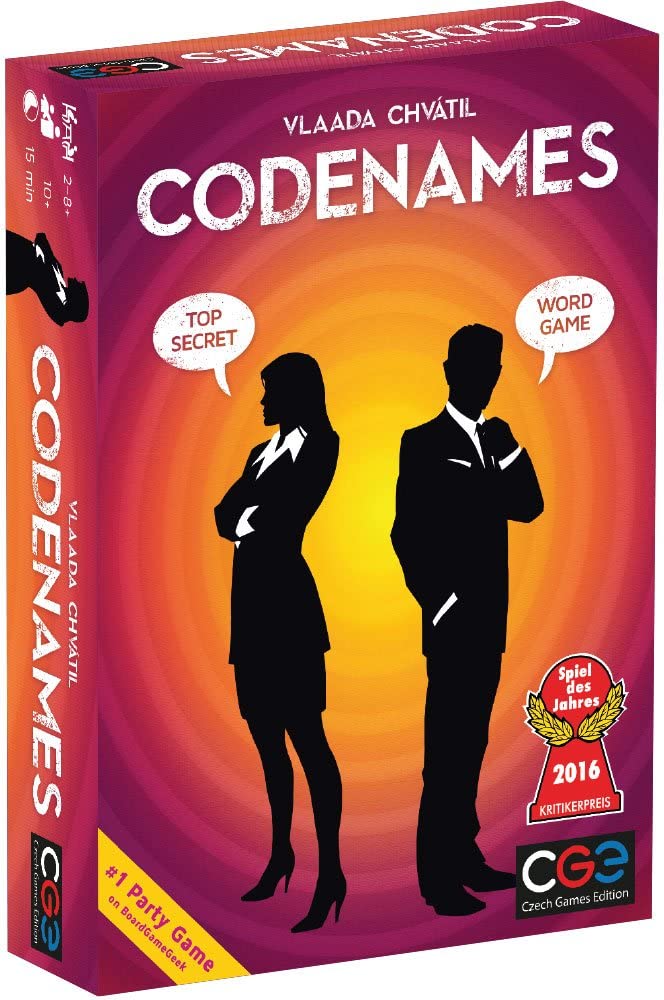
Editor’s Rating:
About the Game
Czech Games Codenames is a strategy-based word puzzle game. Spymasters must reveal secret codenames of the other players, without giving the opposition the information they need to crack their own codes.
- For 2 8+ Players
- 15-minute playing time
- Age 14 and up
Is It Classic?
This is not a traditionally ‘classic’ game. However, the word-puzzle aspect of it does bring it back into the territory of classic games. Plus, there is a strategy that the “spymaster” needs to implement, and the “agents” need to work together without blowing their cover to the opposing team.
The Age Range
This is a game that is not suitable for younger players. Teenagers and adults alike will enjoy this game. The game is inoffensive though, so little ones are not going to pick up anything negative from being in the same room where this game is being played. The only restriction is the complexity of the word-puzzle portion of the game which may be too much for young players.
Ease of Setup
This game is extremely easy to set up as there are only a few different components: cards that make up the “board,” a timer, and player stands.
- This game can be taught to a new player in under two minutes.
- It is a great party game.
- Strategic
- The game is extremely short.
2. Clue
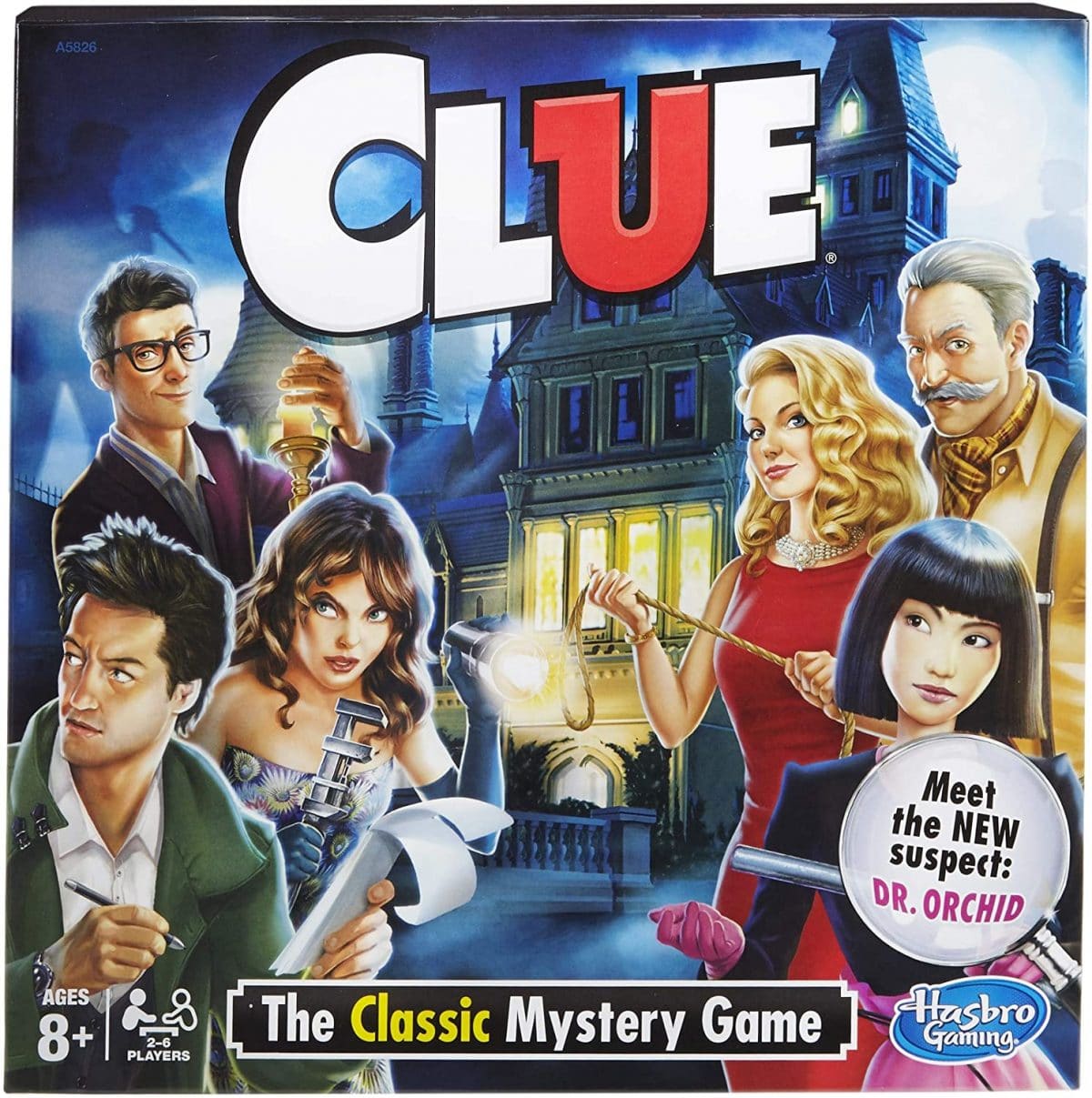
Editor’s Rating:
About the Game
Who doesn’t want to find out whether it was Professor Plum in the library, with the candlestick – or perhaps Colonel Mustard, in the kitchen, with the revolver? This is a game that makes detectives out of each player, as they figure out, from the six suspects, who was the one who committed the murder?
- For 2-6 Players
- 45 Minutes-1 Hour
- Age 8 and up
Is It Classic?
Yes, Clue, which was first released in the US in 1943, is a classic game. Many generations have enjoyed playing this game and the interest doesn’t seem to be slowing down at all. After all, everyone loves a good mystery.
The Age Range
While this game is not suitable for young players, due to the concept of finding a murderer. It’s advised to be suitable for ages eight and up. Since the game plays on your imagination and is reactive to the individual player’s choices, this is a great game to play with family and friends.
Ease of Setup
Although it does take quite a few minutes, due to building the mystery, it becomes easier over time. The box includes gameboard, 4 character tokens, card deck and instructions.
- This game is easy to learn.
- It is a great family game.
- Pieces are not the best quality.
3. Best for Young Children: Candy Land Kingdom of Sweet Adventures
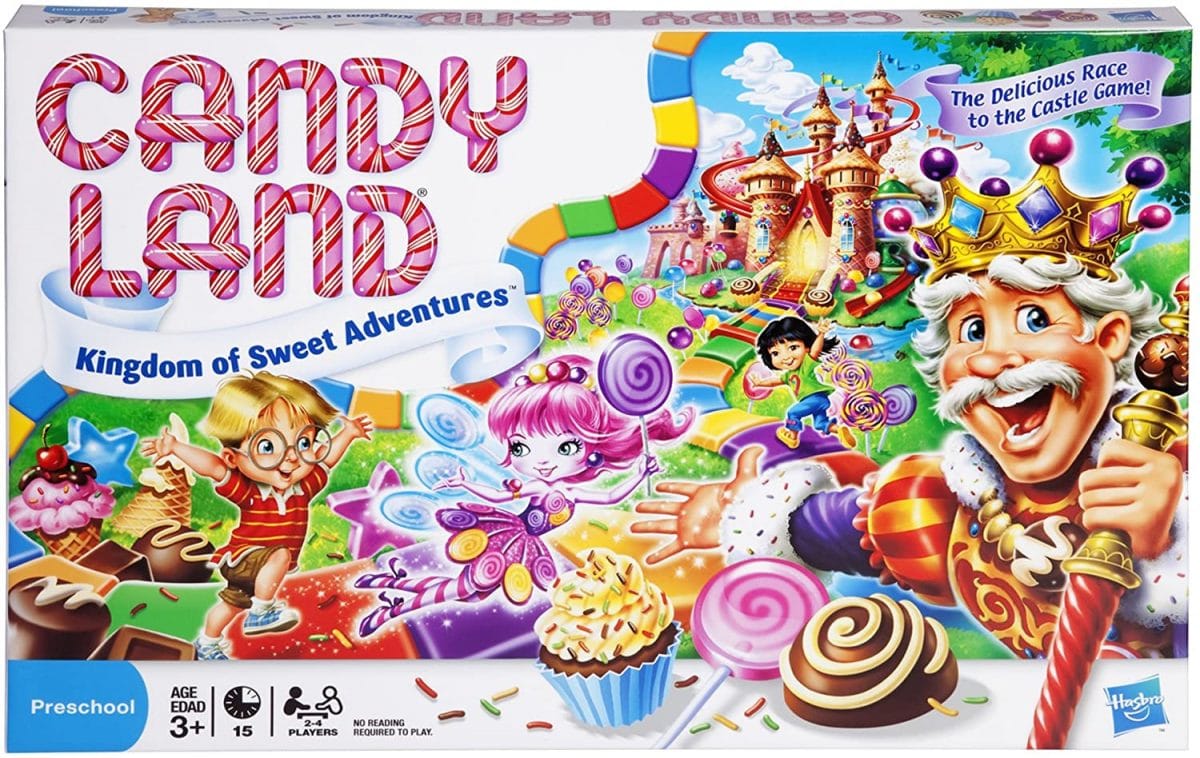
Editor’s Rating:
About the Game
Are you ready to immerse yourself back into the Kingdom of Sweet Adventures? Candy Land is a game that almost every child played at one time over the course of the last seventy years. Join your family members and friends in a race to the castle, but beware, there are both sweet and sour treats lining your path.
- For 2-4 Players
- 15-Minute playtime
- Age 3 and up
Is It Classic?
Absolutely. This game is about as classic as you can get. It was first introduced in America in 1949 and besides getting more colorful, the characters and core gameplay haven’t changed all that much.
The Age Range
This is a game that can be played by pretty much anyone. There is no need to be able to read, as the game moves are decided through colors, so it is suitable for young children. Yet, the experience and imagination of this game keeps the attention of older candy adventurers too.
Ease of Setup
Considering the age-range that this game primarily caters too, this game is exceptionally easy to set up. The game comes with one gameboard, 4 character tokens, a card deck and instructions.
- There is no learning curve for this game.
- This is an excellent first game for children.
- It is a popular game that most people recognize immediately.
- The gameboard squares are smaller than in previous versions.
4. Best Educational Game: Zingo
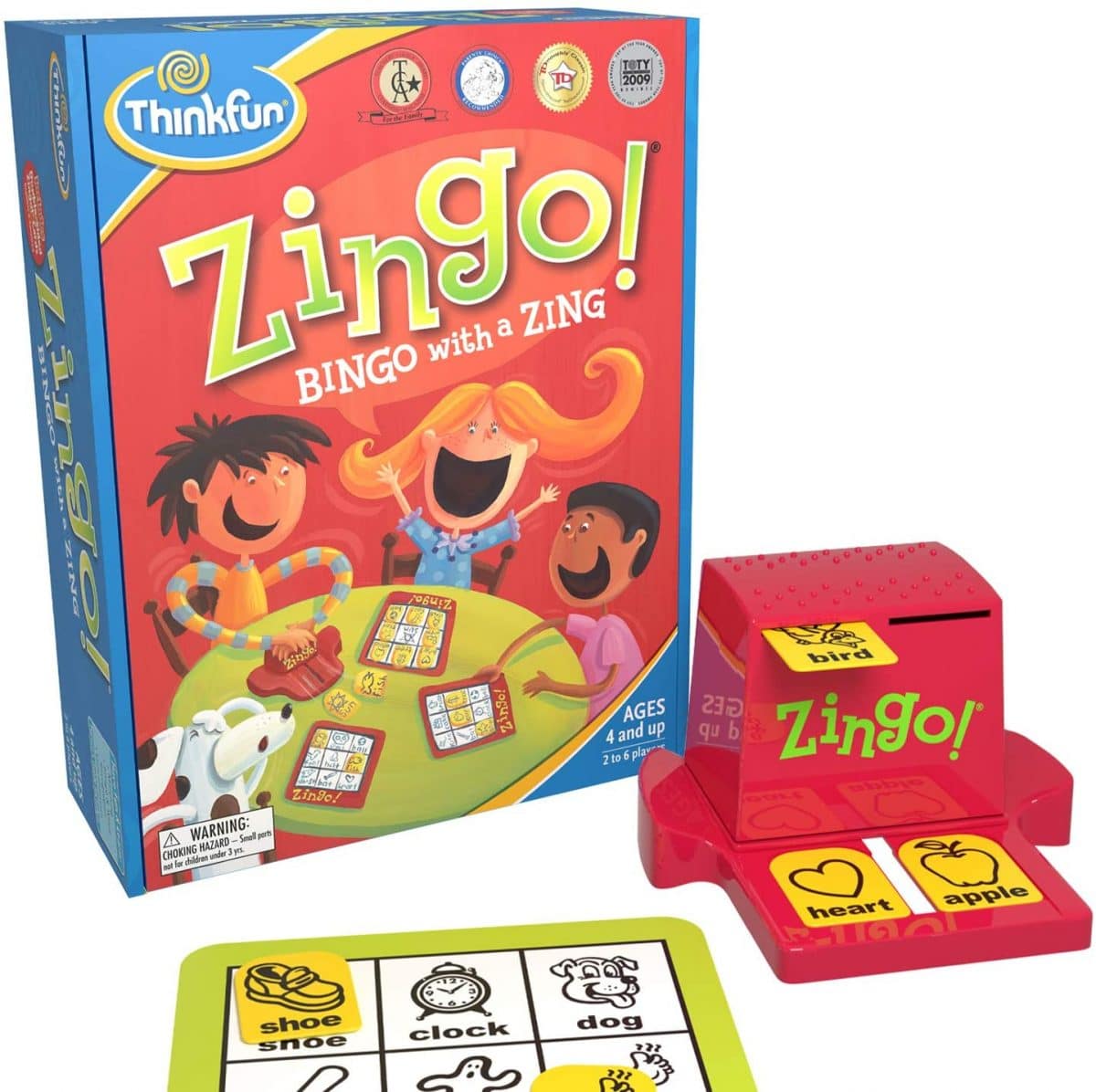
Editor’s Rating:
About the Game
This game puts a fun twist on Bingo, by encouraging kids to match the words to the pictures on their challenge cards.
- For 2-6 Players
- 15-Minute playtime
- Age 4 and up
Is It Classic?
Zingo is not a classic the traditional sense but the core aspects of the game (Bingo and Matching) do make the game a fun twist on two otherwise different classics.
The Age Range
This is a game that can be played by a wide variety of players. However, this is a very young child-friendly game. Adults are likely only going to play this with their young children and once their children advance to a higher reading level, the game will likely get stale.
Ease of Setup
The setup and the cleanup of this game is easy, as it is just challenge cards and tiles. There are not a lot of little pieces that can get lost with this game. It is a straightforward as far as the setup and packing away is concerned.
- This is an awesome early-education game.
- It comes with a guide to help parents make the most out of the game for their kids.
- Players might get bored with the game quickly if they are fast learners.
5. Sorry!

Editor’s Rating:
About the Game
A fast-paced game where players draw cards to determine how far and fast they move on the board, avoiding obstacles along the way.
Why ‘Sorry’? Because it’s a word you’ll need to say a lot as you send your opponents pawns back to the starting grid and make them start all over again. Known as the game of sweet revenge, keep people on side to keep the fire off you and herd your group of pawns into the finishing gate before anyone else.
- 2-4 players
- Ages 6 and Up
- 15-45 min playtime
Is It Classic?
This version is new, but the original has been around since 1929!
The Age Range
Six and up is recommended for this game. The brutality of resetting your opponents’ scores can be upsetting for young children (and adults!)
Ease of Setup
With a deck of cards for movement, a board, and 12 pawns, this board game is very easy to set up.
- Easy to play
- Very competitive
- Quick finish time
- One person can get picked on
- Only currently under $20, can be listed for slightly more than that
6. Monopoly Game: Disney Frozen 2 Edition

Editor’s Rating:
About the Game
Players take a trip with Anna and Elsa as they venture through Arendelle and beyond with this Frozen take on the classic Monopoly.
- For 2-6 Players
- 45-Minutes-Hour playtime
- Age 8 and up
Is It Classic?
Monopoly is about as classic as it gets. Originally devised by Lizzie Magee as a way to teach people about how unchecked capitalism can cause terrible situations, instead people saw it as an outlet for their rapacious inner tycoons and the game soared in popularity.
The Age Range
This game has smaller pieces and can be difficult to understand as the rules are relatively complex. Therefore, the game age limit is 8+. Beyond that, though, this is a game that can be played by anyone.
Ease of Setup
The setup for this game takes a little longer and is more involved than most of the other games on this list.
- This is a fun recreation of a classic game.
- The game helps people understand how budgeting your money is important.
- This game also teaches negotiation skills.
- The game could be a little complicated for a young player.
- Monopoly causes family wars.
7. Inspiration Play Double Ditto

Editor’s Rating:
About the Game
Double Ditto is an intriguing, out-of-the-box thinking game where players are challenged to think on their feet and guess what fellow players are thinking.
- For 4-10+ Players
- 25-Minute playtime
- Age 10 and up
Is It Classic?
No. This game is an original concept that is great for party games. While it isn’t a classic game, players sure seem to have a lot of fun playing it.
The Age Range
This is a fun game for all players, 10 and up. Whether you are being silly with a younger crowd or trying to outsmart your fellow adults, this game will always be an interesting, one of a kind challenge to all who play.
Ease of Setup
This game is easy to set up. It includes 400 category cards, a 15-second timer, score sheets, and an instruction card. The rest of the game comes out of the players’ imagination.
- This is a game that helps exercise creativity and quick-thinking.
- Game changes depending on the crowd you play it with
- Unique
- Creativity is a must, or this game tends to get old fast.
8. Best Premium Pick: Trivial Pursuit

Editor’s Rating:
About the Game
This is the trivia game that started it all. Whether you are a connoisseur of random facts or you have a favorite category, playing Trivial Pursuit gives you the time to shine.
- For 2-6 Players
- 60- 80+ Minute Playtime
- Age 16 and up
Is It Classic?
Yes. Trivial Pursuit first came out in 1981 but the retro gameboard and packaging makes the game look older. Despite its age, this was the first trivia game of its time and has quickly solidified itself into the classic gameboard hall of fame.
The Age Range
Considering this game is based off trivia, it makes sense that an older teen and adult audience would have the most fun playing it. There is a lot of reading involved and some of the facts and questions are quite advanced, even for teenagers.
Ease of Setup
This game is easy to set up, with only a gameboard, 400 cards, 1 die, 6 wedge holders, and 36 wedges. The only thing players need to keep track of is the wedges, as they can easily get left out of the box or hidden in the box.
- Trivial Pursuit is a fun way to learn a wealth of information.
- The concept of the game is perfect for those who love trivia.
- Good for showing off to your friends and family.
- The game can be frustrating and difficult for some players.
- If you don’t know the answers, there is little you can do.
9. Pay Day

Editor’s Rating:
About the Game
Pay Day is a simple board game where you move through the 30 spaces that represent the days of the month whilst taking out loans and using the money you have to get to the next Pay Day. The object of the game is to have the most money at the end of the game. Loans can be taken out, property deals can be made and interest will have to be paid as you try to navigate life’s little obstacles.
- 2 – 4 players
- Ages 8 and up
- 30 – 60 minutes playtime.
Is It Classic?
Yes, Payday has been around since 1975 and has remained popular throughout. Humans like playing for even pretend money and this game is no different.
The Age Range
The rather “mature” nature of the obstacles means it’s generally best for ages 8 and up, though a young child could play with adult supervision and guidance.
Ease of Setup
There’s quite a lot to set up, with money, counters and cards, so it’s not the easiest game to get started.
- Relatable to real world problems
- Rewards careful strategy
- The luck elements mean the weaker players can still win
- Depressingly real
10. Chutes and Ladders
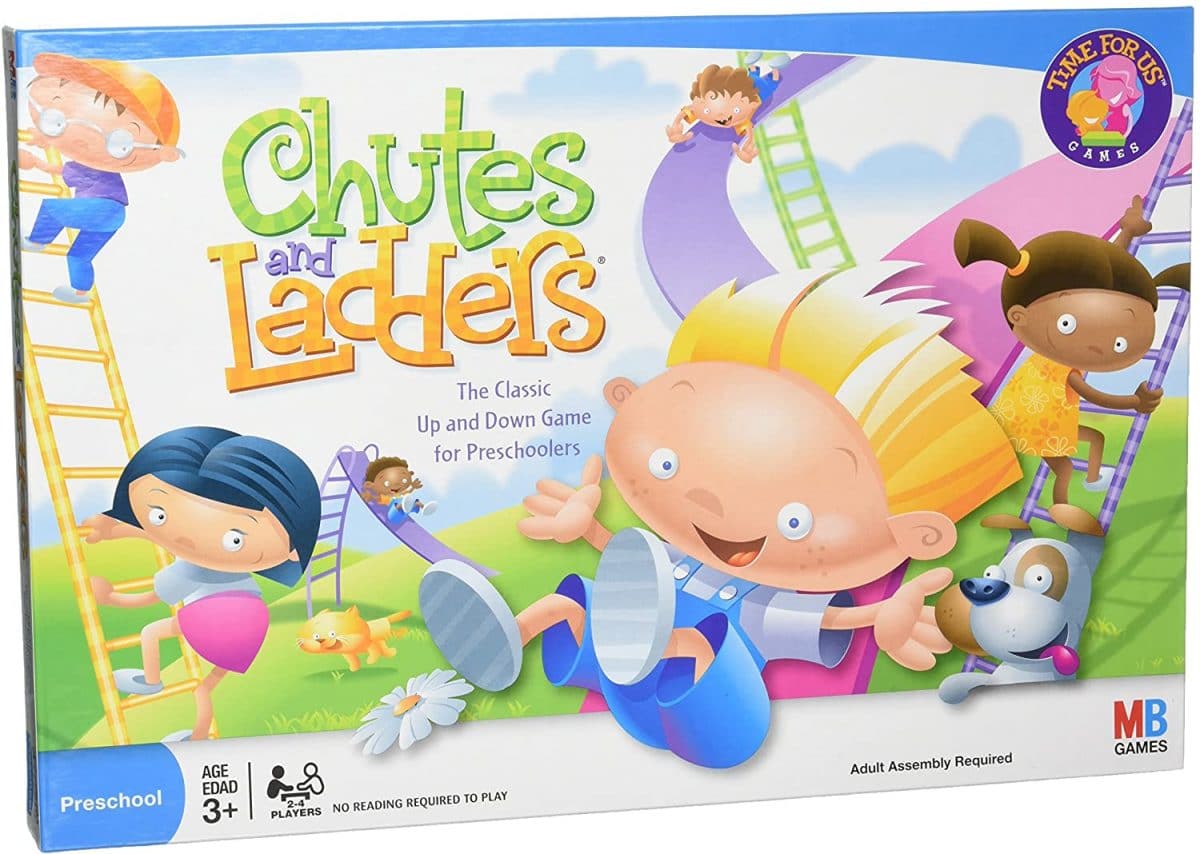
Editor’s Rating:
About the Game
Chutes and ladders is the game that has taught children morality in the United States since 1943. This game started out as Snakes and Ladders but evidently, that was a little too scary for kids, because the Americanized version promptly replaced the snakes with chutes. This game teaches kids (and reminds adults) that every action has a consequence. Sometimes that consequence is good and sometimes it is bad. However, it also teaches kids that no matter what, even if they make a mistake, they can always earn their way back and get a second chance to make the right decision.
- For 2-4 Players
- 15-Minute playtime
- Age 3 and up
Is It Classic?
Chutes and Ladders is definitely a classic. There is nothing that is more classic than a good old-fashioned morality lesson, wrapped up in a child’s game. Many kids grew up both playing this game and learning from it. So, it is only natural that new parents would want to share this game with their children.
The Age Range
This game is for ages 3+ but it really is only for kids. Most of the time, nostalgia is not going to make adults or older kids want to play this game. Yet, for younger kids and their parents, this is a great game to teach them about the realities of life in a safe and non-stressful manner.
Ease of Setup
This game is easy to set up, as there is only a gameboard, cardboard cutout players, plastic stands for the players, and a spinner. The rest of the game is played directly from the board.
- This is a great game to teach kids counting and colors.
- The lessons children learn from this game will help shape their moral compass.
- The gameboard and pieces are not made of the most durable material.
- The 100% luck-based mechanics make it shallow

